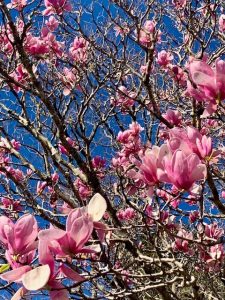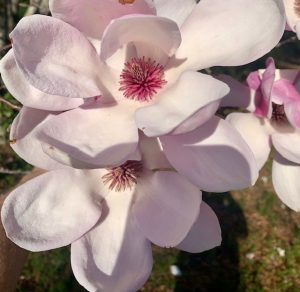In addition to our native Southern magnolia, Magnolia grandiflora, there are a number of other magnolia species to consider for use in our North Florida landscapes. In addition to the evergreen types, there are deciduous types, as well. While the Southern magnolia is evergreen and blooms in mid-spring, a number of the deciduous magnolias bloom during mid-winter to early spring.
Today, I’ll share an article written by Gary Knox, UF/IFAS Extension Horticulture Professor Emeritus. Knox writes about some of these worthwhile magnolias to consider for use in our landscapes.

One of the first magnolias to bloom is the Saucer or Japanese magnolia, Magnolia x soulangeana. This is a small to medium tree that will be covered with rose

pink flowers in mid to late winter. Saucer magnolias are renown for their heavy flowering, but they are also infamous for flowering so early in the year that frosts often damage their flowers, turning them into brown mush.
Another early flowering magnolia is the Yulan magnolia, Magnolia denudata. This beautiful tree is greatly appreciated by gardeners for its fragrant, alabaster white flowers and graceful tree form. Yulan magnolia is not grown as widely as Saucer magnolia because it is difficult to propagate by cuttings. This makes it harder to locate a nursery selling them, but a worthwhile purchase if you find one! Unfortunately, Yulan magnolia flowers also sometimes succumb to frost damage.
Try one of the newer, later-blooming magnolias to avoid the problem of frost damage to flowers. The Gresham Hybrid magnolias were developed by the late D. Todd Gresham who combined the beautiful flower character, color and size of Magnolia campbellii, a beautiful Asian magnolia, with hardiness and young flowering age of Saucer magnolia. The resulting hybrids are noted for producing large numbers of flowers up to twelve inches in diameter on vigorous, small to medium trees. Flowers range in color from deep purple-red to alabaster white and typically occur later than those of Saucer magnolia. Outstanding cultivars include Pink Goblet, Jon Jon, Sayonara, Winelight, Full Eclipse and Darrell Dean.
Look for these and other outstanding magnolias at a local nursery or garden center. Although they are not yet grown as widely as Saucer magnolia, they are increasing in popularity and are becoming more available.
More information on these and other magnolias is available from the UF/IFAS Extension Office in your county or through this UF/IFAS Extension website: https://edis.ifas.ufl.edu/topics/Magnolia.
 1
1
